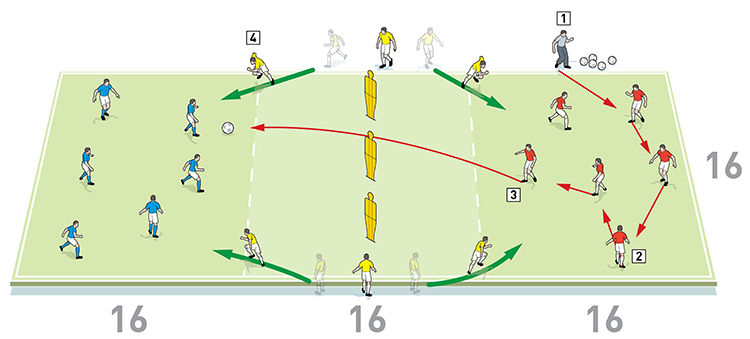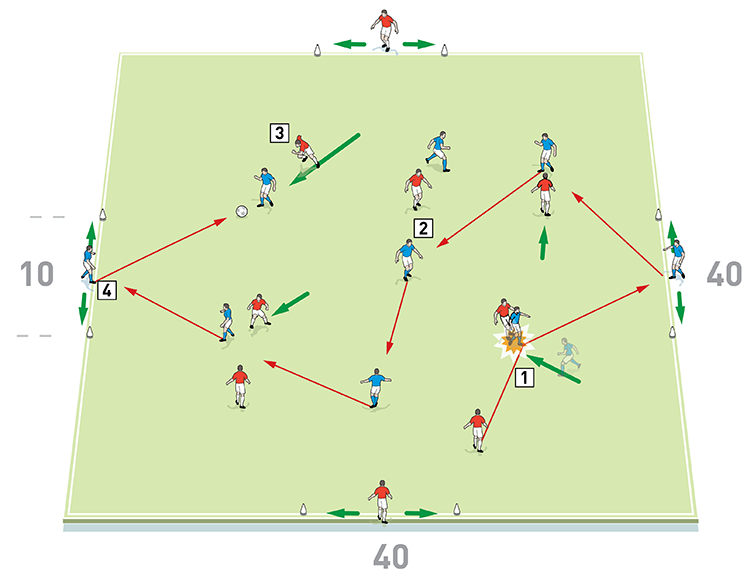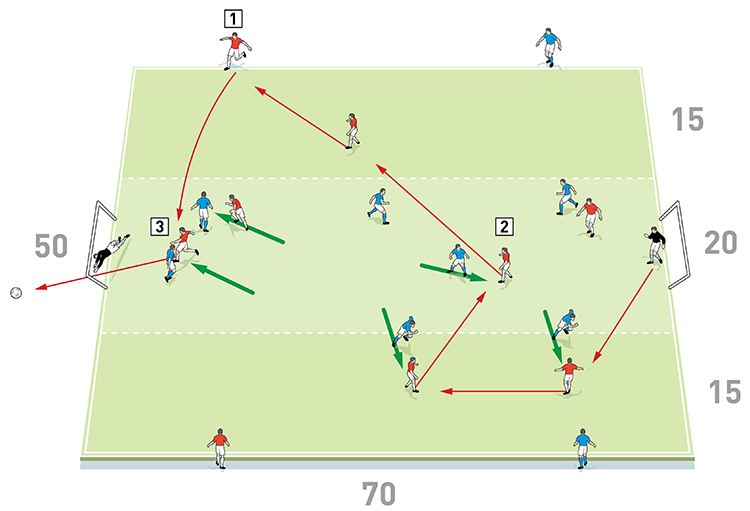You are viewing 1 of your 1 free articles
Switching play to score
Coach your players how and when to switch play to create goal-scoring opportunities – the different activities in this session have a lot of technical, tactical, physical, social and physiological elements within them. These keep the players focused, while also maintaining the sense of competition.
| Area | Up to 70x50 yards |
| Equipment | Balls, bibs, cones, 3 mannequins, 2 full size goals |
| No. of Players | 18 players + 2 goalkeepers |
| Session Time | Passing & movement: 15mins, Possession & switching: 20mins, Possession to switch play: 20mins, 9v9 game: 20mins |
This session is all about coaching players how and when to switch play to create goal-scoring opportunities. The different activities have a lot of technical, tactical, physical, social and physiological elements within them. These keep the players focused, while also maintaining the sense of competition, which we think is vital to the success of the session.
Winning is really important so it has to be a factor in our training, but we also need to know that learning is taking place so that the players can achieve the targets set for them. The losing team might be asked to perform little forfeits, as we find this keeps standards high while keeping the players engaged.
We tend to run this session whenever we think we are coming up against a team that is really organised and compact. There might not be any space to play through the opposition, so we have to understand that switching play regularly will move their units and create space and problems in different areas.
What do I get the players to do?
Passing & movement
We set up an area of 25x25 yards. We are using 18 players split into two teams of nine. We set up as shown [1], with each team positioning two players on cones about ten yards apart at each end. The remaining players begin in the centre.
Each team starts with a ball at one end and has to work it across the square unopposed. In the diagram we have the reds moving the ball from the bottom of the area to the top and the blues are passing it from one side to the other.
Each team uses good passing, quick movement and effective combination play to move the ball from end to end. When the ball reaches the opposite end, the two outside players at that end join the play in the centre and are replaced by their two nearest team mates.
We can progress this activity in a number of ways: by limiting the touches to just two or three, or by conditioning players to move after they pass. We can also insist they have to perform a one-two before passing to the end player.
We play for 15 minutes in blocks of three minutes.
1

2. At the same time, the blues work the ball across the area. Here they start with a pass between the two end players
3. When the ball has been transferred across the area, the two receiving end players go into the centre and their nearest team mates replace them
What are the key things to look out for?
We find this activity gets the players thinking about moving the ball quickly and switching it from side to side with a tempo and quality that we would expect to see from them on match day.
We want the players to think about their passing skills, particularly the type and weight of their passes. We also want them to work on their receiving skills and see that they are checking over their shoulders.
This introductory practice should get them focusing on the themes that we want to see from them throughout the session.
What do I get the players to do next?
Possession & switching
We set up in an area of 48x16 yards, divided into three 16x16-yard zones and with three mannequins in the centre zone. We’re using 18 players split into three teams of six. Two of the teams start in opposite end zones, while the third team waits outside the centre zone.
Play starts with the coach serving to one of the end teams. They must make five passes before they can transfer the ball to the opposite end by passing through or over the mannequins, as shown [2]. This pass serves as a trigger for two players from outside the centre zone to enter the end zone and press. The new possession team must then make five passes before transferring the ball back again through the mannequins.
We can progress this practice by limiting players to two touches, or by conditioning them to make 10 passes before transferring the ball.
Play for 20 minutes in blocks of two minutes. Each team has to have at least two goes at pressing.
2

2. The possession team must make five passes under pressure from two yellow pressers before they can switch the ball to the other end
3. To transfer the ball to the other end, it must be passed between the mannequins
4. When the ball enters the opposite end zone, two outside yellow players can enter that zone to press
What are the key things to look out for?
This activity should make the possession players think about when and how to switch the play while being pressed. As it’s 6v2, we expect they should be able to keep possession but their decision making is now being tested – after the five passes have been made, look to see what kind of pass players use to transfer the ball from end to end, and whether they force play despite knowing the defenders can press the other zone straightaway.
What do I get the players to do next?
Possession to switch play
We set up an area of 40x40 yards with 10-yard gates marked out with cones on each side. We are using 18 players split into two teams of nine. Each team has two end players standing in gates on opposite sides and the remaining seven players from each team start in the central area, as shown [3].
The aim is for the team in possession to use clever movement and passing to move the ball across the area from one end player to the other.
The opposition must press to turnover possession and if they succeed, they should play the ball to one of their end players as quickly as possible and then try to switch it to the opposite side.
We can progress the practice by limiting touches and by restricting passes to under head height.
Play for 20 minutes and make sure all players have two turns on the outside.
3

2. After passing it to their end player, the blues now try to switch the play to the opposite end player using good passing and movement
3. The reds press and try to regain the ball
4. The blues score when the end player receives the ball. Then they try to work it back across to score another point
What are the key things to look out for?
One of the most important things to look for in this practice is good decision making. After regaining the ball, we need to see players understanding when they need to build play in order to create openings to switch, and when they can do it immediately and switch the play in less passes – or even in one pass.
How would you put this into a game situation?
9v9 + goalkeepers
We set up an area of 70x50 yards, with a goal and a goalkeeper at each end. We have two 15-yard wide zones marked out down the length of the area and a 20-yard centre zone. We’re using 18 outfield players divided into two teams of nine. It’s 7v7 in the main area and each team has two wingers stationed outside the playing area at their team’s attacking end, as shown in the diagram [4].
4

2. It’s 7v7 inside the main area. The ball must stay under head height and it must be switched from one zone to the next before a shot can be taken
3. To encourage switching play, an extra point is awarded if the ball has passed through all three zones and to the wide player before a goal is scored
We expect players to take all the information from the previous practices into this game to see if learning has taken place – we want to see if they can switch play with quality at the correct time.
We play a normal game but the ball must stay under head height. To score a goal, the ball must be passed from one zone to another before the shot and is worth one point. To encourage switching play, we award two points for a goal scored after the ball has been passed through all three zones and has been crossed by one of the wide players outside the playing area.
We play three games, adding different conditions for the second and third games. We play the basic rules for the first game, but we make everyone two-touch for the second game to promote quick thinking and swift combination play. In the third game, we allow the ball to go over head height. Also, on regaining possession we allow teams to pass from any zone straight to the far wide man and we award two points if they score from the cross. We do this to encourage switching play over longer distances.
We play for 20 minutes, making the losing team do a forfeit after each game.
How do I progress the session?
As coaches, we need to keep challenging the players. We usually progress the activities when we see that players have grasped what we want from them. We do this by taking away touches, or we may make the area sizes smaller – this gives the players less time on the ball, so decision making has to become quicker and better.
What are the typical mistakes that players might make, and how do I avoid them?
Players will often try the switch when it is not on – they will try to force play when maybe an extra pass might be the better option. And sometimes they will take extra passes when a more direct switch is needed. That’s why decision making is so important.
It’s also vital that players understand their roles once the play has been switched. They should know the positions they should take up to offer another passing option.
To avoid any mistakes, after each activity we will talk to the players about the key points we want to achieve, as we believe the more we drip-feed information, the more the players will learn.
Related Files
Editor's Picks
Deep runs in the final third
Using the goalkeeper in build-up play
Pressing principles
Intensive boxes drill with goals
Penetrating the final third
Creating and finishing
My philosophy
Pressing initiation
Compact team movement
Coaches' Testimonials

Alan Pardew

Arsène Wenger

Brendan Rodgers

Carlos Carvalhal

José Mourinho

Jürgen Klopp

Pep Guardiola

Roy Hodgson

Sir Alex Ferguson

Steven Gerrard
Coaches' Testimonials

Gerald Kearney, Downtown Las Vegas Soccer Club

Paul Butler, Florida, USA

Rick Shields, Springboro, USA

Tony Green, Pierrefonds Titans, Quebec, Canada
Join the world's leading coaches and managers and discover for yourself one of the best kept secrets in coaching. No other training tool on the planet is written or read by the calibre of names you’ll find in Elite Soccer.
In a recent survey 92% of subscribers said Elite Soccer makes them more confident, 89% said it makes them a more effective coach and 91% said it makes them more inspired.
Get Monthly Inspiration
All the latest techniques and approaches
Since 2010 Elite Soccer has given subscribers exclusive insight into the training ground practices of the world’s best coaches. Published in partnership with the League Managers Association we have unparalleled access to the leading lights in the English leagues, as well as a host of international managers.
Elite Soccer exclusively features sessions written by the coaches themselves. There are no observed sessions and no sessions “in the style of”, just first-hand advice delivered direct to you from the coach.









